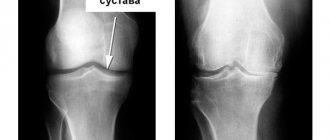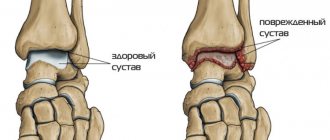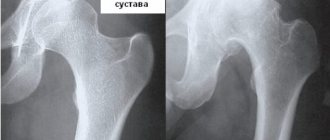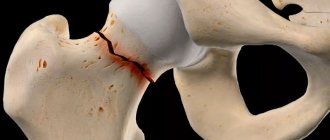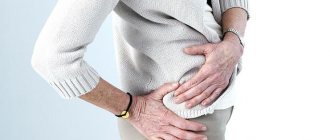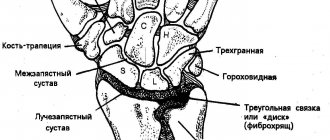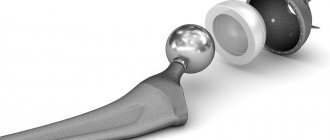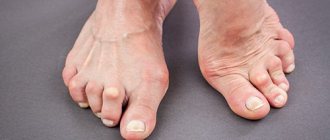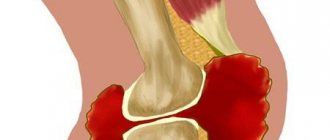Diseases with inflammation of bone and cartilage tissue are familiar to many people. Medicine has noted an increase in the number of patients diagnosed with post-traumatic arthrosis of the ankle joint. The pathology develops gradually. Sometimes it takes a chronic form. The tissues become thinner. Over time, they become deformed and destroyed.
The danger of the disease lies in the possible loss of mobility of the lower extremities. Then the person may remain disabled forever. Timely diagnosis and treatment helps prevent dangerous trends.
Definition of disease
The essence of the disease lies in the development of degenerative processes occurring in bone and cartilage tissues. Deforming external influence (traumatic injury) leads to a chronic form of the disease.
Degenerative-dystrophic changes affect the structure and shape:
- Hard tissues;
- Articular cartilage;
- Tendons;
- Blood vessels;
- Muscles;
- Nerves.
Injury leads to deformation and loss of tissue functionality.
Damage disrupts the structure of solid parts. Small cartilaginous elements break off. Even greater damage is caused to bone surfaces. The sensitivity of the receptors in the joint increases, and pain is felt.
After an injury, synovial fluid is not produced as intensively. Cartilage tissue is less well lubricated. Their food is becoming poorer.
As a result of the injury, the joint space narrows. This can lead to bone fusion.
In injuries with ligament ruptures, the tissue gradually scars. The rupture site becomes a focus of inflammatory processes.
Pathology develops in patients from different age groups. However, this form of arthrosis more often affects young, active and physically active people. The probability of post-traumatic arthrosis of the ankle ranges from 15% to 60%.
Prevention measures
The basis of preventive measures is to prevent injury and reduce the risk of injury by any available means. If an injury has already occurred, then following certain rules can help prevent the appearance of arthrosis:
- Completely carry out the treatment prescribed by the doctor, following all his instructions;
- take chondroprotectors (after consultation with a specialist);
- reduce the load on the ankle joints.
If you notice any symptoms of ankle arthrosis, you should definitely consult a doctor. In no case should you waste time with this disease, otherwise serious complications cannot be avoided. The sooner you seek help from a specialist, the faster you will be able to cure this disease. You should never take it to extreme measures; always take care of your joints.
Degrees and types of disease
The emergence and development of pathology is determined by 4 stages. At first, the changes are invisible. There is morning stiffness in the joints. Treatment needs to begin.
At the second stage, swelling is observed, and a crunching sound is heard when moving. The former mobility of the lower limb is limited. X-rays illustrate that the interarticular gap is decreasing. Morning stiffness lasts longer. Lameness may occur.
The third stage is characterized by the manifestation of deformation of the joints. The muscles atrophy. Movements are significantly limited. The ankle requires constant rest. But even with inactivity, pain is felt.
At the fourth stage, mobility is severely impaired. The joint gap almost disappears. X-ray shows noticeable proliferation of osteophytes. In such cases, only surgical treatment is used.
Doctors classify the following forms of post-traumatic arthrosis:
- Lightweight;
- Acute;
- Deforming.
Post-traumatic ankle arthrosis can develop slowly. The patient gets a chance to start treatment in a timely manner. Then the likelihood of slowing down the progression of the pathology increases.
Men aged 20 to 60 years are at risk of post-traumatic illness. Pathology among women occurs between the ages of 19 and 55 years.
Joint structure that contributes to injury
The ankle joint is a trochlear joint. The block is formed by the talus bone of the foot and the articular concavity of the tibia, and is laterally limited by two ankles. Based on its structure, the range of motion and mechanisms of ankle injuries become apparent. The block-shaped shape of the joint provides the main function of flexion-extension of the foot with a slight possibility of its deviation to the sides.
It is this possibility that, in some cases, becomes a precedent for injuries. To prevent traumatic ankle injury, wearable shoes play an important role.
Often high heels deprive the foot of the necessary stability and lead to repeated damage to the joint. High weight and polyneuropathy, which accompany diabetes mellitus along with osteoporosis, can contribute to dislocations, subluxations, and intra-articular fractures of the ankle, which subsequently leads to the formation of post-traumatic deforming arthrosis.
Symptoms of the disease
At the initial stage of the pathology, symptoms appear weakly or are absent altogether. The victim does not always feel pain. Discomfort or swelling is not immediately detected.
But even minor injuries affect human health. The slightest damage affects capillaries and nerve fibers. The nutrition of joint tissues is weakened. Metabolic processes are disrupted.
After injury, the lower limb may hurt. A slight swelling appears. There is a feeling of discomfort when moving.
Such symptoms disappear quickly. The person believes that the danger has passed and the injury has healed. A necessary visit to the doctor is postponed indefinitely.
But after a few days, weeks or months, the disease may manifest itself. Post-traumatic processes have not stalled. They just slowed down.
When standing for a long time, the patient unknowingly twists his foot. The same movement occurs when walking. Increasingly, pain and discomfort are felt in the ankle joint.
Alternative medicine
An alternative therapy method, developed over the years, can perfectly complement drug treatment for arthrosis. Proper combination of them will significantly speed up the process of restoring ankle mobility. There are a myriad of recipes for treating ankle arthrosis at home. The effectiveness of each depends on the individual characteristics of the human body and the stage of advanced disease. The most popular are:
Recipe No. 1. Sew ankle cuffs, completely stuffing them with fresh or dry birch leaves, and wear them at night. With regular use, pain subsides and regeneration of joint tissue improves.
Recipe No. 2. 2 tbsp. spoons of dry string are poured with boiling water (1 cup). Leave for half an hour, take two tablespoons. three times a day. This is an excellent anti-inflammatory, wound healing agent that helps normalize metabolism and calm the nervous system.
Recipe No. 3. Crush a green burdock leaf several times, apply it to the ankle, and wrap it overnight. You can also grind it in a blender and apply the paste on your feet, insulating it. The procedure is also done before bedtime. Burdock is cartilage tissue's best friend. It promotes the removal of salts, improves clinical parameters of blood and urine.
Recipe No. 4. Massage with honey. To carry it out, you need to take a small amount of the main ingredient, rub it into the ankle joint with intense movements, but so that it does not cause discomfort, for about 15 minutes. Then wrap it in gauze, insulate it, and leave for 2 hours.
Recipe No. 5. Crushed chalk is mixed with kefir to obtain a paste and applied as a compress to the ankle. Wrap in cling film, insulate, and leave overnight.
Such simple ingredients have helped fight the manifestations of arthrosis for more than one generation. Their undoubted advantage is efficiency and low cost.
To reduce the risk of complications after injuries in the form of post-traumatic joint damage, you need to adhere to a number of simple rules:
1. treat any injuries in a timely manner, especially fractures of the lower extremities. It often happens that quickly started therapy is abandoned halfway and untreated injuries manifest themselves as arthrosis.
2. Keep your weight under control. Extra pounds place a greater load on the cartilage tissue of the ankle.
3. Balance physical activity. Excessive tension is just as harmful as physical inactivity.
4. Protect the ankle from hypothermia.
5. If a person knows the factors of predisposition to joint diseases, he needs to take chondroprotectors for preventive purposes, focus on a healthy lifestyle and proper nutrition.
6. From time to time, do special gymnastics aimed at unloading cartilage tissue, swim in the pool.
7. Choose the right shoes. It should have a small (3-4 cm) stable heel, not squeeze.
Consequently, untreated fractures and other injuries often cause the development of a complication - arthrosis. It is necessary to recognize the disease at an early stage, when the ankle can still be treated conservatively and with folk remedies. Otherwise, surgical intervention will come to the rescue. But this is a much more expensive method with long-term rehabilitation and possible negative consequences.
Etiology (causes, conditions of occurrence) of the disease
The causes of the disease are common injuries. Damage can be sustained during:
- General or partial cleaning;
- Work on a summer cottage;
- Going down the steps;
- Exit from public transport;
- Sports training.
Post-traumatic arthrosis is caused not only by bruises, blows, and falls. Tight or uncomfortable shoes are among the causes of the disease. Microtrauma to ligaments and tendons can occur when walking in high heels for a long time.
Post-traumatic arthrosis is caused by various types of injuries. The occurrence and development of the disease is caused by:
- Subluxations;
- Dislocations;
- Sprains;
- Partial or complete ruptures of ligaments and tendons;
- Meniscal tears;
- Fractures;
- Bone cracks;
- Surgical interventions.
Excessive exercise
accelerate wear and tear on the ankle joint. Strength and game sports cause the occurrence of post-traumatic arthrosis.
Overweight people are at greater risk of injury. Joint problems affect those who have any degree of obesity.
With age, cartilage tissue loses its elasticity. Damage to the ankle in older people leads to severe forms of the disease.
Among the causes of the disease are salt deposits and harmful working conditions. It is risky to spend the whole day on your feet without giving them rest.
Therapeutic measures
Treatment of arthrosis necessarily involves complex therapy. The main goal of treatment is aimed at:
- getting rid of the causes of the disease;
- elimination of unpleasant symptoms (pain and swelling);
- restoration of motor function of the joint;
- prevention of subsequent development of the disease.
For this, all possible methods are used: physiotherapy, medications, traditional medicine, physical therapy, massage.
Medications
The main drugs of choice during post-traumatic arthrosis are non-steroidal anti-inflammatory drugs, manufactured in various forms (ointments, creams, tablets, injections). Most often, with severe symptoms, these medications are prescribed internally and externally. The duration of the course and the required dosage are determined by the doctor individually. In unadvanced cases, only drugs for external use can be used. These drugs do not enter the bloodstream and therefore have minor negative consequences for the human body.
In addition to non-steroidal anti-inflammatory drugs, medications are prescribed to relieve symptoms. These are decongestants (in the form of compresses, baths) and painkillers. Most often, a specialist prescribes chondroprotectors, which are designed to activate bone tissue regeneration. The main active elements in these drugs are glucosamine and chondroitin.
Folk remedies
In addition to medications, various folk remedies can be used at home. They can also eliminate pain, swelling and inflammation. The following methods are considered the most popular:
- Before going to bed, you can apply fresh burdock leaves to the affected area;
- rub olive oil into the joint every day after a night's rest;
- At night, you can apply a compress of finely chopped cabbage leaves to the affected area;
- Apply mummy compresses twice a day; it can also be taken orally;
- add a small amount of olive oil to finely chopped comfrey and rub into the joint twice a day;
- take lard and mummy in equal proportions, mix these components and refrigerate for one week, apply this mixture twice a day.
Important: traditional methods of treatment alone will not help prevent the subsequent development of pathology. But in combination with other methods and medications, they will significantly speed up the process of complete recovery.
Physiotherapeutic procedures
Physiotherapy helps restore metabolic processes in the affected part of the foot, helps relieve swelling and pain, and activates recovery processes. The most common methods of physiotherapy are:
- healing mud;
- magnetic therapy;
- infrared radiation;
- laser treatment;
- paraffin therapy;
- electrophoresis.
Without fail, physiotherapeutic procedures must be carried out under the supervision of a specialist. Today, there are a large number of devices on sale that are designed to perform a course of physiotherapeutic treatment at home. Before choosing any device, you must consult your doctor. Any of these treatment methods has certain contraindications and restrictions on use.
Physiotherapy methods also include massage. It activates lymph and blood circulation, promotes the removal of decay products and the supply of oxygen, as well as medicinal and nutritional elements, to the joint tissues. During the massage, it is forbidden to make sudden movements.
Set of exercises
Set of exercises
Therapeutic exercises are an indispensable method in the treatment of arthrosis. It is during moderate physical activity that the interaction of joint surfaces and the movement of synodal fluid occurs. This promotes the penetration of nutrients and medications into bone tissue and its regeneration.
A set of exercises for arthrosis should only be compiled by a doctor on an individual basis. After performing therapeutic exercises under the supervision of a specialist, the patient must carry out it at home. The key to effective treatment is regular exercise.
Surgery
Surgery
In the absence of a positive result of conservative therapy, surgical methods are used. Today there are a large number of different methods of surgical intervention. The operation allows you to install a high-quality prosthesis instead of the damaged joint.
During endoprosthetics, plastic, steel, and ceramic prostheses are used. After this prosthetics, the patient will be able to return to a full life for 25 years.
Another type of surgery is arthroplasty. Parts of the bone tissue are preserved. With this method, the cartilage is artificially immobilized.
At the final stage, patients are rehabilitated after the surgical procedures performed. In this case, radical treatment methods are combined with other methods.
Healthy eating
Healthy eating
A healthy diet plays an important role during the treatment of ankle arthrosis. Patients are recommended to eat dishes with gelatin. These can be jellied dishes or jellied meat. It is necessary to control the amount of vitamins taken, for which a set of different products is being developed. The daily diet should be based on fruits, vegetables, dairy products, fruit drinks, and fresh juices. It is possible to take balanced vitamin complexes.
Menu features are agreed upon with a nutritionist. The doctor will be able to help the patient adjust his weight and restore metabolic processes in the body. You need to eat food in small portions. It is important to follow a regular diet. During treatment, experts do not advise drinking carbonated drinks and alcohol. You will also need to give up cigarettes.
Diagnostic methods
Visual examination carried out in the early stages of the disease does not reveal significant changes. Disorders of the joint configuration are difficult to notice.
Feeling helps to identify thickening in the ankle area. Palpation may reveal irregularities along the edges of the joint space. Using the method is accompanied by painful sensations.
It is very important to diagnose the slightest anatomical defects. Transformation of the relative position of the articular surfaces of the ankle by only 1 mm increases overload in certain areas. With such deformation, the pressure is not distributed evenly over the surface of the cartilage. Only 30–40% of the total area is used. Rapid destruction of cartilage tissue is caused.
The final diagnosis is made based on:
- History (information about injuries received);
- Clinical manifestations;
- X-ray results.
An x-ray helps to identify various dystrophic changes.
In the photographs you can see deformation and flattening of the articular platform. Irregularities and narrowing of the joint space and disturbances in the axis of the limb become noticeable. To more accurately determine the situation, computed tomography (CT) is used. To examine soft tissues, MRI (magnetic resonance imaging) is prescribed. It is advisable to use arthroscopy as prescribed by the doctor.
Timely diagnosis determines effective treatment methods. Then degenerative-dystrophic processes slow down. Pain syndromes are relieved. Mobility and functionality are restored.
Pathophysiology of arthrosis
The ankle joint is designed in such a way that it allows the load to be distributed over the maximum area in order to minimize pressure on the articular surfaces. Injury to these surfaces can reduce the contact area between articular cartilages. As a result, the pressure in the undamaged areas of the joint increases, which leads to accelerated wear and tear and the formation of arthrosis.
The development of osteoarthritis occurs in five main stages:
- Damage to the joint surface
- Inflammation of the synovium
- Chondrocyte necrosis
- Sclerosis of the end plates of the susava
- Disorganization and necrosis
Specifically, when articular cartilage is damaged, it becomes rough. The friction of rough surfaces against each other causes the formation of fine particles. The synovial membrane reacts to these particles as a foreign substance that should not be in the joint with chronic inflammation. By creating enzymes for their lysis (resorption) and healing of cartilage. Under such conditions, chondrocyte hypertrophy and collagen formation decrease. In severe cases of arthrosis, the subchondral layer may undergo erosion of the articular surface, thereby forming cysts. This is already 3-4 degrees of arthrosis.
Principles and methods of treatment
Treatment of post-traumatic arthrosis of the ankle joint is carried out by traumatologists and orthopedists. The main goals of overcoming pathology include:
- Reduction of pain syndromes;
- Elimination of obstacles to normal movements;
- Restoring the functionality of the ankle;
- Prevention of further destructive processes.
Post-traumatic arthrosis occurs after receiving internal or external injuries. Their consequences must be treated as quickly and effectively as possible.
Surgical intervention
In the absence of positive dynamics of conservative treatment, surgical methods are used. At the moment, there are a sufficient number of methods of surgical intervention for post-traumatic arthrosis of the ankle. Each of them has its own advantages and disadvantages, contraindications. Depending on the indications, it is possible to perform arthroplasty, arthrodesis, endoprosthetics and other methods.
